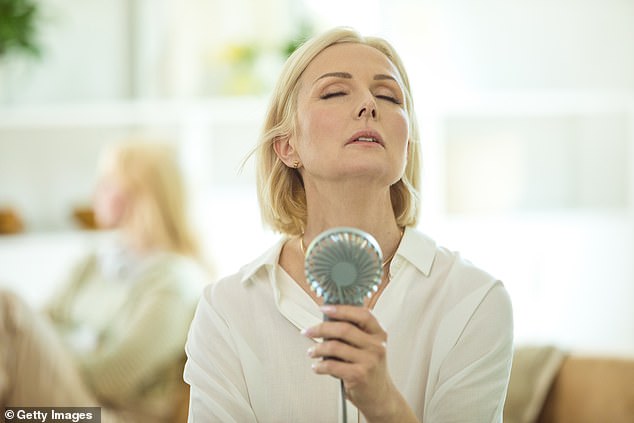After developing menopausal symptoms at age 49, I was put on hormone replacement therapy patches and took them until I was 65. The hot flashes continued while on them and got worse to the point that, now that I am 70, the slightest exertion causes sweat to pour down my face and soak my hair. What could be causing this?
Dr. Ellie answers: It is very possible that sweating is still due to menopause and lack of estrogen.
However, the fact that it first appeared while I was taking HRT would indicate that something else was going on.
It is worth knowing that there are no longer arbitrary limits on how long someone can use HRT.
If hormone replacement therapy controls sweating and hot flashes caused by menopause, it can be continued afterward at the lowest possible dose, usually in the form of patches.
Facial redness and sweating may be related to a skin condition called rosacea.
For someone who does not want to use hormones but suffers from severe redness, an alternative non-hormonal medication can be tried.
Clonidine is a drug for high blood pressure, but it is licensed for use in the menopause. It is worth checking with your GP whether this might help and whether it is safe.
However, facial redness and sweating may be related to a skin condition called rosacea, which is common in postmenopausal women and causes redness and flushing of the face.
This is accompanied by an intense sensation of heat. There are topical medications available on prescription, such as brimonidine cream or metronidazole gel, which can calm the rosacea or redness and in turn reduce sweating. It is worth asking your GP for a prescription to try one of these.
Facial sweating may also not have an underlying cause and this is called primary hyperhidrosis.
There are specialized treatments – such as botox – to reduce sweating and this may be an option once you have been referred to a dermatologist.
Every morning I have sticky, swollen eyes. I am 77 years old and take ibuprofen and co-codamol for arthritis. Could my problems be a side effect of this treatment?
Dr. Ellie answers: This would not be a typical side effect of ibuprofen or co-codamol. Sticky, watery eyes are a common condition called blepharitis. It can be uncomfortable and irritating.
The eyelids are often covered with scabs and secretions, which are usually worse in the morning. They may also look swollen and feel gritty. You may see pockets of fluid because the small glands in your eyelids may be clogged.
Treating blepharitis is a daily routine called eyelid hygiene, which unblocks the glands. First, warm the skin of your eyelids to allow the fluid to drain. You can do this with a flannel soaked in very hot water for up to ten minutes, or you can buy heat packs online.
Second, massage your eyelids to remove fluid from the glands. Finally, clean your eyelids. You can pick up cleansing liquid or wipes for blepharitis on the street. A safe alternative is diluted baby shampoo.
Regular sticky eyes can also be caused by allergic conjunctivitis, perhaps related to hay fever or an infection. If this were the case, the eyelid hygiene method would not help and advice from the pharmacist would be necessary.
I am 90 years old and for several months I have had a rash with spots and infection on my chest. A blood test suggested I had low sodium and I was put on pills for three months, but they didn’t help. Neither do steroid creams. What should I do?
Dr. Ellie answers: Rashes can be difficult to diagnose and several treatment tests or visits to the GP may be necessary to get a definitive answer. Even then, it is not always possible to find a miracle cure.
Low sodium levels don’t usually cause this type of rash, but whatever is causing it could.
For example, we know that certain medications, such as antidepressants and blood pressure pills, can reduce and also cause a drug-induced skin rash. Your GP or pharmacist will be able to review the medicine.
Steroid ointments are commonly used for skin problems and tend to work if something is inflamed, such as eczema or other types of dermatitis. If it doesn’t work, there are two possibilities. Firstly, a strong enough steroid may not have been tested. Secondly, a steroid may not work at all if the problem was due to an infection.
Skin infections are not uncommon and one of those that causes a blotchy rash would be folliculitis. This causes small red pustules and spots and can be caused by bacteria or a yeast infection.
A type of yeast folliculitis is more likely in someone with dandruff. A GP might take a sample from one of the spots to check what bug is present. For yeast folliculitis, an antifungal shampoo is used as a body wash.
For bacteria it would be an antibiotic and would require a prescription.
Trying an antifungal shampoo with ketoconazole, available over the counter, as a body wash is a low-risk option.
If the wait for a dermatology appointment is too long, you can ask for teledermatology, where photos are sent to a dermatologist instead.
The burden of failed holiday operations
Medical tourism – the large numbers of people flocking to Turkey and other destinations for cheap cosmetic surgery – is putting huge pressure on the NHS, the British Medical Association warned last week.
Like almost every other doctor, I have seen it often. Someone goes abroad to have cosmetic surgery or a hair transplant, and when they return home, everything starts to fall apart.
No one thinks it will happen to them, but complications are common, particularly if you immediately get on a plane and the aftercare instructions are in another language.
Six Britons died last year after procedures in Turkey and many more end up with infections or problems requiring an admission to the NHS. However, failed operations or unpleasant results will not be fixed.
I would like to know if you are a medical tourist and are delighted with the results, or did you have a bad experience?



